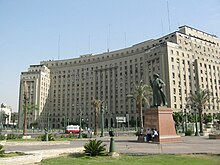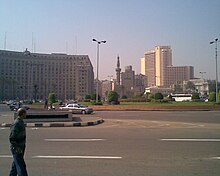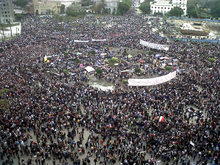Tahrir Square: Difference between revisions
TahrirSquare (talk | contribs) |
TahrirSquare (talk | contribs) Tag: possible conflict of interest |
||
| Line 43: | Line 43: | ||
{{Commons-inline|ميدان التحرير|Tahrir Square}} |
{{Commons-inline|ميدان التحرير|Tahrir Square}} |
||
* [http://www.sightseebyspace.com/view_link.php?txt_link_autoid=698 Satellite view of Tahrir Square - SightseeBySpace.com] |
* [http://www.sightseebyspace.com/view_link.php?txt_link_autoid=698 Satellite view of Tahrir Square - SightseeBySpace.com] |
||
* [http://www.tahrirsquare.net Tahrir Square Website] |
|||
<!---image updated---[[File:Cairo - arab chain revolutions.JPG|thumb|pictures of the Protests in Tahrir Square]]---> |
<!---image updated---[[File:Cairo - arab chain revolutions.JPG|thumb|pictures of the Protests in Tahrir Square]]---> |
||
[[Category:Downtown Cairo]] |
[[Category:Downtown Cairo]] |
||
Revision as of 05:26, 12 February 2011
30°02′40″N 31°14′09″E / 30.044422°N 31.235696°E

Tahrir Square ([ميدان التحرير Midan al-Tahrir] Error: {{Lang-xx}}: text has italic markup (help), IPA: [meˈdæːn el-, ettæħˈɾiːɾ], English: Liberation Square) is a major public town square in Downtown Cairo, Egypt. The square was originally called Midan Ismaileyya (English: Ismailia Square), after the 19th-century ruler Khedive Ismail, who commissioned the new downtown district's 'Paris on the Nile' design. After the Egyptian Revolution of 1919 the square became widely known as Tahrir (Liberation) Square, but the square was not officially renamed until the Egyptian Revolution of 1952, which changed Egypt from a constitutional monarchy into a republic.[1]
Features


At the centre of Tahrir Square is a large and busy traffic circle. On the north-east side is a plaza with a statue of Ottoman Egypt-era Cairene Omar Makram, and beyond is the Omar Makram Mosque.[2]
The square is the northern terminus of the historic Qasr al-Ayn Street, the western end of Talaat Harb Street, and an via Qasr el-Nil Street across its south direct access to the Qasr al-Nil Bridge crossing the nearby Nile River.
The area around Tahrir Square includes the Egyptian Museum, the National Democratic Party-NDP headquarters building, the Mogamma government building, the Headquarters of the Arab League building, the Nile Hotel, and the original downtown campus of the American University in Cairo.

The Cairo Metro serves Tahrir Square with the Sadat Station, which is the downtown junction of the system's two lines, linking to Giza, Maadi, Helwan, and other districts and suburbs of Greater Cairo. Its underground access viaducts provide the safest routes for pedestrians crossing the broad roads of the heavily trafficked square.
Public use and demonstrations
Tahrir Square has been the traditional site for numerous major protests and demonstrations over the years, including the 1977 Egyptian Bread Riots, and the March 2003 protest against the War in Iraq.[3]
2011 Egyptian Revolution

Tahrir Square is the focal point of the 2011 Egyptian Revolution against president Hosni Mubarak.[4] Over 50,000 protesters first occupied the square on 25 January, during which the area's wireless services were reported to be impaired.[5] In the following days Tahrir Square continued to be the primary destination for protests in Cairo.[6] On 29 January Egyptian fighter aircraft flew low over the people gathered in the square. On 30 January, the seventh day of the protests, BBC correspondents reported that the number of demonstrators had grown to at least 100,000,[7] and on 31 January Al Jazeera correspondents reported that the demonstrations had grown to at least 250,000 people.[8] On 1 February, Al Jazeera reported that more than 1 million protesters peacefully gathered in the square and adjacent streets.[9]

The square became established as a focal point and a symbol for the ongoing Egyptian democracy demonstrations. On the night of 2 February, violence between the pro-Mubarak and pro-democracy demonstrators erupted in the square and its approaches, with pavements being broken up for use as projectiles. Within a week, due to international media coverage, the image and name of Tahrir Square became known worldwide.[10]
A Facebook page by the name tahrir square ميدان التحرير was maintained by a rotating staff of 20 at one point during the uprising, particularly to offset the lack of, or distorted, coverage of the events in state-run media.[11][12]
Tahrir Square erupted in a massive celebration on 11 February 2011 when Hosni Mubarak officially stepped down from office.[13]
See also
References
- ^ Vatikiotis, Panayiotis J. (1997). The Middle East: From the End of Empire to the End of the Cold War. Routledge. p. 194.
- ^ "Midan Al-Tahrir, Liberation Square". Tour Egypt.
- ^ Hiel, Betsy (2005-06-19). "Egyptian reformers taking it to streets". Pittsburgh Tribune-Review.
- ^ BBC News: Egypt protests: Anti-Mubarak demonstrators arrested, 26 January 2011. Accessed 2011.01.26.
- ^ "Egyptians report poor communication services on Day of Anger". Almasry Alyoum. 2011-01-25. Retrieved 2011.01.25.
{{cite web}}: Check date values in:|accessdate=(help) - ^ BBC News: "Egypt protests: curfew defied in Cairo and other cities" 29 January 2011. Accessed 2011.01.29.
- ^ BBC News: "Egypt protesters step up pressure on Hosni Mubarak" 31 January 2011. Accessed 2011.01.31.
- ^ Al Jazeera News: Live blog 31/1 — Egypt protests, 31 January 2011. Accessed 2011.01.31.
- ^ Al Jazeera News: Protesters flood Egypt streets, 1 February 2011. Accessed 2011.02.01.
- ^ Al Jazeera News: "Battle of Tahrir Square" 03 February 2011 . Accessed 2011.02.03
- ^ Fahim, Kareem and Mana El-Naggar; Liam Stack and Ed Ou contributed reporting, "Emotions of a Reluctant Hero Galvanize Protesters", The New York Times, February 8, 2011 (February 9, 2011 p. A14 NY ed.).
- ^ tahrir square, Facebook page. Retrieved 2011-02-11.
- ^ Kirkpatrick, David D. and Anthony Shadid from Cairo. Other reporting was contributed by Kareem Fahim, Liam Stack, Mona El-Naggar and Thanassis Cambanis from Cairo, and Alan Cowell from Paris, “Mubarak Steps Down, Ceding Power to Military” ,The New York Times, February 11, 2011.
External links
![]() Media related to Tahrir Square at Wikimedia Commons
Media related to Tahrir Square at Wikimedia Commons
